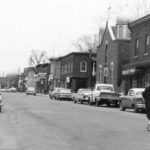History
From the first year of Ukrainian immigration to Canada in 1891, many Ukrainian immigrants visited Ottawa. Some of these immigrants stopped in Ottawa on their journey to Western Canada and found temporary employment. The first permanent Ukrainian residents settled in Ottawa in approximately 1905. They worked on the railway, in the lumber industry, in construction and other manual labour occupations. In 1908, these Ukrainian immigrants founded the Prosvita (education) Association, the first Ukrainian cultural association in Ottawa.
By 1914, there were over 200 Ukrainians in Ottawa. Under the leadership of Rev. J. Fylyma, founding meeting of 70 heads of families was held on October 11, 1914 to organize a Greek- Catholic (the designation for Ukrainian Catholics at that time) parish with a permanent parish priest. The new parish was called the Ruthenian (Latin term for Ukrainians) Catholic Church of St. John the Baptist. Church services were held in a rented Roman Catholic Church on Sussex Street, but in 1916 the church was destroyed by fire. Church services were then held at the Franciscan Fathers chapel on Wellington Street.
In 1918, a building was purchased on the corner of Rochester and Balsam streets and converted into a church. The new church now under the leadership of Father M. Kuzmak was consecrated by Bishop Nicetas Budka. Near the church, another building was erected for use as a Ukrainian school and as the Prosvita cultural center. Under the new leadership of Rev. Wasyl Gegeichuk, the Ukrainian Catholic Parish began to expand its activities in 1919. The cultural center was enlarged and a choir, amateur dramatic circle, mandolin orchestra and dancing club were organized. The parish cultural groups also performed outside the Ukrainian community.
In 1966 the parish moved to a new location on the corner of Carling and Irving and built a hall, which was used as a church, intending to build a church on that site at a later date. However, since that site was too small, and additional land could not be acquired, the present site on Green Valley Crescent was acquired in 1984. This site is ideally suited for the Shrine since it is bordered on the east side by the historic Rideau Canal, and on the south by a major thoroughfare: Heron Road. In 1987, the building of the church was completed and designated as a Sobor (Shrine) and a national monument to commemorate the Millennium of Christianity in Ukraine (988-1988).
The interior decoration of the church (iconography and stained glass windows) began in the fall of 1999, and was completed in December 2000. The main artist was Professor Lubomyr Medvid’ from Lviv, Ukraine. Assisting him was Stepan Yuzefiv. The windows designed by Professor Medvid’ were produced on site by Mykola Shymchuk, Orest Tarnavskyj and Ihor Tarnavskyj, all from Lviv, Ukraine.

